By John Smith
John Smith, our senior researcher, joined the RAN College in 1946 and retired as a Commander having specialised in gunnery. He served in many RAN ships and had operational service in Korea, the Malayan Emergency and Vietnam. Post navy he had various managerial positions, the last being CEO of the Sydney Maritime Museum. He is a former Vice President and has been a volunteer since 2003.
Aeons ago, when I was serving in the Navy, junior officers and ordinary seamen were expected to be able to Box the compass. That is that they should be able to recite the compass points of the magnetic compass in clockwise order and this in the days when gyro compasses were practically universally installed in warships. Indeed the 1964 Seamanship Manual still contained the magnetic compass rose.
However, this article is about a different form of boxing, i.e. the often so called gentlemanly art of boxing in accordance with the Queensberry rules. For many years it was a popular public spectator sport. How many of you remember taking a tram from the city to that ramshackle building, the Rushcutters Bay Stadium in Sydney to watch a boxing match (when it was built it was the largest roofed in structure in the World and held 12000 people).
It is therefore to be expected that it should be popular in the navy. After all, it was easy to set up if space was available for the ring and suitable superstructure nearby from which the crew could watch and barrack. There was always plenty of rope to fence it off and it could be carried out either at sea or in harbour, onboard or ashore.
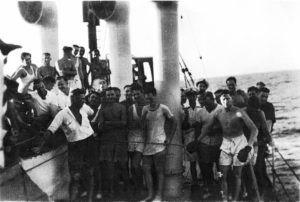
In the twentieth century it was considered to be an official Naval sport and the rules for matches were included in the book “The Royal Navy and Royal Marines Sports Handbook”.
The earliest reference I can find to boxing in the Royal Navy is quoted in Michael Palin’s book “Erebus The Story at A ship” where on New Year’s day 1842, the crew of HMS Terror, then in the Antarctic came across to Erebus and danced on deck until five in the morning, after which there were one or two pugilistic matches in the forecastle, which peaceably ended.
In the Navy, boxing was a popular inter departmental and internship competition, and the first annual Royal Australian Navy Boxing championships were held in June 1920.
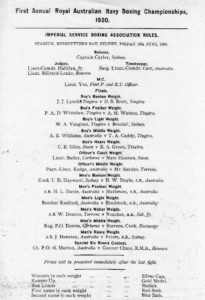
In 1921, the firm WJ Sanders crafted the solid silver Colin Rodgers Cup for the annual Fleet boxing championship. It is now in the Naval Heritage Collection.
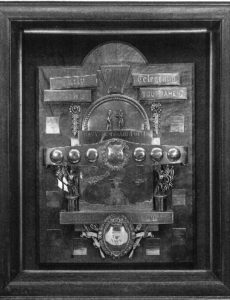
Another interesting trophy which is on display in the RAN Heritage Centre, Garden Island, Sydney is the 2UW/Daily Telegraph Boxing Tournament Shield competed by the Navy, Army & Air Force and which was won by the Navy.
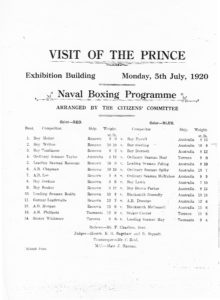
The first RAN Fleet Championship in June 1920 may well have been a preparatory event for the Naval Boxing event held on 5 July 1920 to mark the visit of the Prince of Wales. It was open to the public.
In the Royal Navy in World War I, the Grand Fleet spent much of its time in Scapa Flow which was not exactly a tourist attraction or indeed, good run ashore. The following extract from Australia’s Argonauts by Peter Jones is an interesting, report of the newly formed RAN’s boxing prowess. “In dealing with this morale challenge Admiral Jellicoe and his successor Admiral Beatty were able to sustain generally good morale. They did so by an active sea training regime and a vigorous sporting program. The centerpiece of the latter was the annual boxing championship.
In 1917 it was held on 22-23 August onboard the battleship HMS Ajax at anchor in Scapa Flow. In the lead up to the event ships conducted preliminary contests in the different weight divisions to decide upon their ship’s champions. To the surprise of the Grand Fleet officers the Australian midshipmen figured prominently in the officers’ bouts. Thousands of Grand Fleet officers and sailors watched from any upper deck vantage point to view the boxing ring set up on the battleship’s deck. In the preliminary fights, Leigh Watkins, Hugh MacKenzie, Harry Showers and Dick Cunningham all won their preliminary bouts. Frank Larkins was then unlucky to lose his match. Perhaps the most memorable match of the first day was Frank Getting’s light heavyweight match which had to be stopped in his favour. At the end of the day a Jervis Bay midshipman was left to contest the finals in each weight division. The following afternoon, Admiral Beatty and other flag officers, viewed the hard-fought finals from ringside seats. Dick Cunningham after weeks of sweating down and starving won the bantamweight championship bout with a technical knock-out in the first round. Harry Showers and Hugh MacKenzie had to fight each other in the preliminary final. Hugh MacKenzie won on points and then went on to win the middleweight in great style. Beatty presented the cups to the winners and Harry Showers received a good loser prize. Norman Calder wrote that he witnessed a great victory for Australia and wrote to Commander Grant (at RANC) with the stunning results.”
Some of the Grand Fleet boxing Championships were held ashore at Flotta.

Back in Australia, boxing tournaments were also held at shore establishments such as Cerberus, Leeuwin and Nirimba. They were considered an important part of the training of cadet midshipmen at the Royal Australian Naval College as the following extract from Work Hard Play Hard, The Royal Australia Naval College 1813-1988 by LCDR I J Cunningham shows. “The ‘manly art of self defence’ was taught at the college as part of PT, with the first official tournament of matches between cadets being conducted in July 1918. The competitors were matched by weight and were all volunteers. Boxing was apparently not as popular as college authorities would have liked, because as a consequence of the disappointing number of entries for 1919, the decision was made that all cadets should enter the 1920 tournament. This set the pattern of boxing at the college for over forty years.

As is usual in boxing, all combatants were graded by weight. The age range of cadets, at least until 1956, was 13-17 years of age, and the weight divisions, starting from the “Paperweight” Division, were correspondingly diminutive. The “Heavyweight” Division was rarely contested. Preliminary elimination bouts were held to determine the last two contenders in each weight division, after which the boxing tournament culminated in a gala occasion as the finalists fought out their respective championships. Trophies were awarded to the victors with the overall best exponent being awarded the “Shelley cup”. The good losers received a cake, a traditional college reward and probably, from the point of view of a cadet, more immediately gratifying than any metal memento.
The boxing finals became a feature social and sporting event, and at FND were held at night, with the ring set up in the gymnasium, surrounded by seating for spectators (mainly officers, masters and their wives and the ship’s company).
Boxing continued at the college until 1976 although the last recorded tournament in the college magazine is for 1975. By the 1970s, compulsory participation had ceased, but with the increased numbers of cadets, there was never a lack of competitors. The reason for the cessation of boxing is not clear. One officer who as a cadet the time and who participated in the last tournament stated that he believed one officer’s wife was appalled at the ‘brutality’ and left the gymnasium in tears, shortly afterwards, boxing was discontinued at the college. On the other hand, social attitudes may have influenced those in command as boxing at all levels declined in popularity in the 1970s. In the 1980s, HMAS Nirimba was the only naval establishment that persisted with boxing of any kind. Instruction in boxing or the sponsoring of tournaments ceased thought out the RAN by 1985.”
Another occasion on which RAN boxing prowess was demonstrated occurred in the Mediterranean Fleet. In 1934 to 1936, HMAS Australia had an exchange cruise with HMS Kent in that Fleet. The following is an extract from the cruise book. “It was very soon after our arrival in the Old Country that the opportunity for gathering boxing bouquets was thrust upon the ship. Owing to injuries, a vacancy had occurred in the Royal Navy team in training at the P and RT School, Portsmouth for the Imperial Services Championships to be held at Aldershot. This was in the heavyweight division.
Rumors of our fistic capabilities had drifted across to Pitt Street, with the result that PO Writer Wilson was asked to step into the breach at the last minute to do battle for the Royal Navy. This on reputation alone. Caught somewhat out of condition, but mindful of the honour of the occasion, Wilson made the most of the short time available and journeyed to Aldershot, where he succeeded in annexing the heavyweight title of the Imperial Services. This is believed to be the instance of an Australian securing a Services title, and reflected very favorably on the ship.
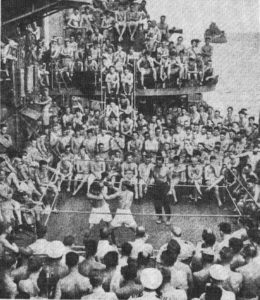
The stage (or rather the ring) next shifted to Alexandria for the 1936 Championships of the Mediterranean Fleet. The number of the ships and the total personnel had increased enormously by the concentration necessitated by the political situation, and it was apparent that in each section and division a considerable amount of elimination would be necessary.
All boxing was held on board the “Glorious” where a spacious hangar provided ideal accommodation. The Novices was the first section called up for settlement. In this division, Leading Seaman Curtis succeeded in taking out the final of the Light-Heavies and A.C. Barnes was runner-up in the Welterweight. “Australia” came out of the tournament 5 points behind the winner, “Glorious” but on top of the Cruiser section.
In the Amateur Championships following. We took the 1st and 2nd in the Heavies (P.O.Wtr. Wilson and Stoker Hill), and 1st in the Middleweight (Ldg.Smn. Madden). In addition, Ord. Smn. Hillen reached the final in the Featherweight and A.B. Ward the final in the Lightweight divisions. Although this tournament was not run on a “team” basis, we headed the list in final placings.
Followed a brief respite before the competitors in the Open section were called upon to shape up for eliminating. The unrestricted class gave the ship’s popular and well-known professional, Wall Hancock, a chance to gather glory for his ship. Wally had previously been bringing his ship’s name to the fore with his successes among the civilians, from four starters in the Open section we collected three titles – Heavy (P.O.Wtr. Wilson) Middle (Stoker Hancock) and Welter (Ldg.Smn Madden). This also secured the aggregate in final results, and is, we believe, without precedent on the Station. That one ship could secure three such titles speaks volumes for the prowess and keenness of our glove-throwers, and has left behind a very respected reputation in this branch of sport.
In summary, our successes on the cruise were as follows;
Imperial Services Heavyweight, 1935 – P.O.Wtr. Wilson
Mediterranean Fleet Championship 1935
Novices
Won Light Heavyweight (Ldg.Smn Curtis)
2nd Welterweight (A.B. Barnes)
(won Cruisers’ Aggregate)
Amateurs
Won Heavyweight (P.O.Wtr. Wilson)
2nd Heavyweight (Sto Hill)
Won Middleweight (Ldg.Smn Madden)
(Fleet Finals Aggregate)
Open
Won Heavyweight (P.O.Wtr. Wilson)
Won Middleweight (Sto Hancock)
Won Middleweight (Ldg.Smn Madden)
(Fleet Finals Aggregate).
In addition to the ratings mentioned above, the following men threw punches in the Mediterranean Fleet Championships, and thus did their share towards our fistic fame: – A.B. Lergessner, Ord.Smn. Dawson, Stoker Burrows, A.B. McDonald, A.B. Rimmer, Ord.Smn. Sanderson and Blk.Petersen.”
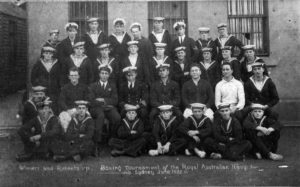
Boxing is no longer an official sport in the R.A.N. Perhaps, interestingly, in the December 2019 issue of the Proceedings of the US Naval Institute is an article by Petty Officer McCoy titled BOXING CAN BOOST THE NAVY’S FIGHTING SPIRIT in which he recommends the reinstatement of boxing in the United States Navy.




